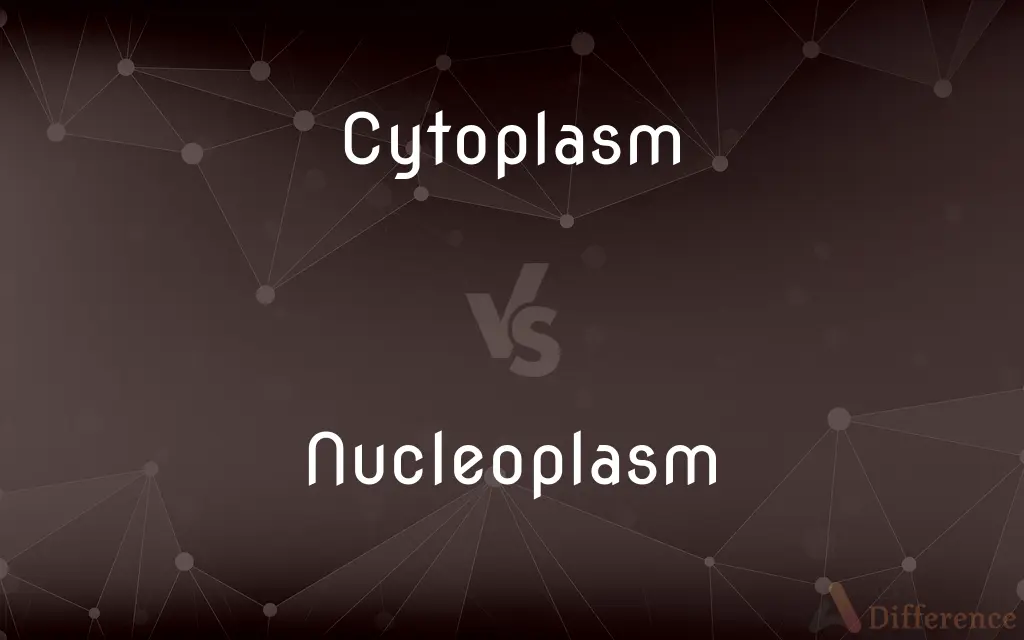Cytoplasm vs. Nucleoplasm — What's the Difference?
By Tayyaba Rehman — Updated on September 21, 2023
Cytoplasm is the gel-like substance within a cell excluding the nucleus, while Nucleoplasm is the viscous fluid inside the nucleus of a cell.

Difference Between Cytoplasm and Nucleoplasm
Table of Contents
ADVERTISEMENT
Key Differences
Cytoplasm and Nucleoplasm are both crucial components within a cell, but they have distinct locations and functions. Cytoplasm is the semi-fluid matrix that occupies the space between the cell membrane and the nuclear envelope. It houses various cell organelles, like the mitochondria, endoplasmic reticulum, and Golgi apparatus.
Nucleoplasm, on the other hand, is the substance found within the nucleus of the cell. This viscous fluid is surrounded by the nuclear envelope and contains the nucleolus, chromatin, and other nuclear components. Nucleoplasm serves as the medium in which sub-nuclear particles are suspended and plays a pivotal role in DNA replication and transcription.
While Cytoplasm is essential for various cellular processes and metabolic pathways, Nucleoplasm primarily aids in the protection and maintenance of the cell's genetic material. The Cytoplasm, being more extensive in its area, provides a dynamic environment where biochemical reactions continuously occur.
In contrast, Nucleoplasm acts as a buffer, maintaining the shape of the nucleus and protecting the DNA within. It ensures the nuclear processes take place smoothly. So, while both Cytoplasm and Nucleoplasm contribute to the overall function of the cell, their individual roles and compositions differentiate them significantly.
Comparison Chart
Location
Between cell membrane and nuclear envelope.
Inside the cell's nucleus.
ADVERTISEMENT
Contains
Cell organelles like mitochondria, ER, etc.
Nucleolus, chromatin, nuclear solutes.
Function
Site for metabolic reactions, supports organelles.
Protects and supports nuclear components, aids in DNA replication.
Consistency
Gel-like substance.
Viscous fluid.
Role in Genetics
Does not directly interact with DNA.
Houses and protects DNA and RNA.
Compare with Definitions
Cytoplasm
Medium for biochemical reactions in the cell.
Glycolysis occurs in the Cytoplasm of the cell.
Nucleoplasm
Viscous fluid inside a cell's nucleus.
Nucleoplasm supports the chromatin and nucleolus within the nucleus.
Cytoplasm
Gel-like matrix inside cells, excluding the nucleus.
The Cytoplasm is where many cellular activities take place.
Nucleoplasm
Maintains the shape and integrity of the nucleus.
The consistency of the Nucleoplasm helps keep the nucleus's form intact.
Cytoplasm
Facilitates transport of materials within the cell.
Nutrients are transported through the Cytoplasm to various cell organelles.
Nucleoplasm
Aids in protection and maintenance of genetic material.
The Nucleoplasm ensures a conducive environment for DNA and RNA.
Cytoplasm
Supports and gives shape to the cell's internal structure.
The Cytoplasm helps maintain the cell's turgidity and shape.
Nucleoplasm
Medium where sub-nuclear particles are suspended.
During DNA replication, enzymes move within the Nucleoplasm.
Cytoplasm
Contains cell organelles and dissolved solutes.
Mitochondria are embedded within the Cytoplasm.
Nucleoplasm
Acts as a buffer for nuclear components.
Nucleoplasm prevents potential damage to the cell's genetic material.
Cytoplasm
In cell biology, the cytoplasm is all of the material within a eukaryotic cell, enclosed by the cell membrane, except for the cell nucleus. The material inside the nucleus and contained within the nuclear membrane is termed the nucleoplasm.
Nucleoplasm
Similar to the cytoplasm of a cell, the nucleus contains nucleoplasm, also known as karyoplasm, or karyolymph or nucleus sap. The nucleoplasm is a type of protoplasm, and is enveloped by the nuclear envelope (also known as the nuclear membrane).
Cytoplasm
The protoplasm enclosed by the plasma membrane of cell, excluding the nucleus in eukaryotic cells and cellular DNA in prokaryotic cells.
Nucleoplasm
The protoplasm of a cell nucleus. Also called karyoplasm.
Cytoplasm
(cytology) The contents of a cell except for the nucleus. It includes cytosol, organelles, vesicles, and the cytoskeleton.
Nucleoplasm
The protoplasm of a cell nucleus
Cytoplasm
The substance of the body of a cell, as distinguished from the karyoplasma, or substance of the nucleus.
Nucleoplasm
The matter composing the nucleus of a cell; the protoplasm of the nucleus; karyoplasma.
Cytoplasm
The protoplasm of a cell excluding the nucleus
Nucleoplasm
The protoplasm that constitutes the nucleus of a cell
Common Curiosities
Do prokaryotic cells have Cytoplasm?
Yes, prokaryotic cells have Cytoplasm but lack a defined nucleus.
Is DNA found within Nucleoplasm?
Yes, DNA is located within the Nucleoplasm of a cell's nucleus.
Can organelles move within the Cytoplasm?
Yes, organelles can move and are suspended in the Cytoplasm.
Is Cytoplasm present in plant cells?
Yes, both plant and animal cells contain Cytoplasm.
Can molecules move freely in Nucleoplasm?
To some extent, but the movement may be regulated based on the molecule's size and charge.
Is Cytoplasm present outside the nuclear envelope?
Yes, Cytoplasm fills the cell space outside the nuclear envelope.
Does Nucleoplasm have a role in transcription?
Yes, transcription, the process of making RNA from DNA, occurs within the Nucleoplasm.
What is the main function of Nucleoplasm?
Nucleoplasm supports and protects the cell's genetic material within the nucleus.
What gives Cytoplasm its gel-like consistency?
The presence of water, proteins, and other solutes give Cytoplasm its consistency.
Is Nucleoplasm unique to eukaryotic cells?
Yes, since only eukaryotic cells have a defined nucleus containing Nucleoplasm.
Does Nucleoplasm aid in DNA replication?
Yes, DNA replication takes place within the Nucleoplasm.
What cellular processes occur in Cytoplasm?
Processes like glycolysis, protein synthesis, and organelle functions occur in the Cytoplasm.
Can ions be found in the Cytoplasm?
Yes, various ions are present and play roles in cellular functions within the Cytoplasm.
How does Nucleoplasm differ from cytosol?
Nucleoplasm is specific to the cell's nucleus, while cytosol is the fluid portion of the Cytoplasm.
Are enzymes present in the Cytoplasm?
Yes, numerous enzymes in the Cytoplasm facilitate metabolic reactions.
Share Your Discovery

Previous Comparison
Courtesy vs. Gesture
Next Comparison
Nymph vs. SirenAuthor Spotlight
Written by
Tayyaba RehmanTayyaba Rehman is a distinguished writer, currently serving as a primary contributor to askdifference.com. As a researcher in semantics and etymology, Tayyaba's passion for the complexity of languages and their distinctions has found a perfect home on the platform. Tayyaba delves into the intricacies of language, distinguishing between commonly confused words and phrases, thereby providing clarity for readers worldwide.













































